Christkindl markets und Glühwein.


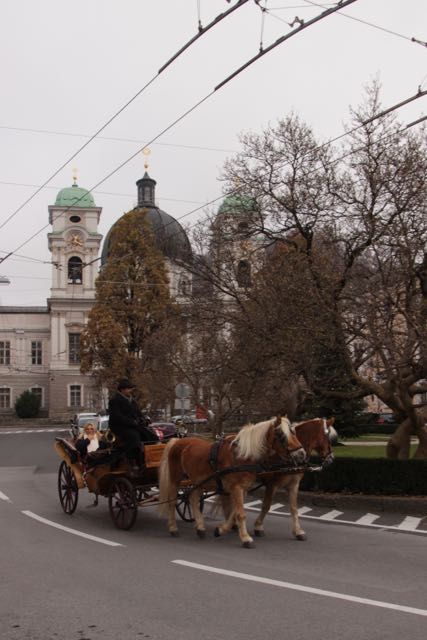
Glühwein stalls speak to Jeanne and I, just as sirens woo sailors onto rocks. Nothing sinister, it's just a fact. They speak in seductive tones and lure us with heady scents of steaming spices steeped in hot red wine. We are led by the nose towards them, so to speak. I have a large nose, so my olfactory senses are assaulted more easily. That's my excuse, anyway. Frosty, night markets and steaming hot glühwein just co-exist. You can't have one without the other. It would be a misalignment of the planets. Romeo without Juliet. The Europeans know how to lead-in to Christmas. The crunch of snow and ice underfoot; the vapour of warm breath meeting chilly air; rows of stalls selling all manner of small Christmas crafts and gifts; stall-holders braving the elements yet smiling through chattering teeth, scarves, and mountains of warm clothing while selling hot pretzels, roasted chestnuts, baked potatoes, soups in breadrolls and other traditional fare. Remember, it's dark just after 4 pm. Huge numbers of local families, as well as tourists, emerge from overly warm Viennese homes and offices to wander the chilly evening stalls. A rule, more than the exception, is to wander with a mug of steaming glühwein, or hot rosé, or heated aperol. It warms the hands, excites the insides and stimulates the nose with its warm fruits, red wine, cinnamon, nutmeg and cardamon spices. Mmmm. Ist sehr gut, danke!
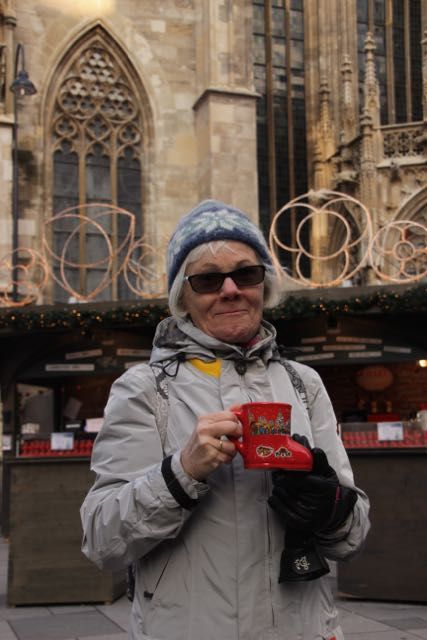

Christkindl (the Christ child) is the unseen gift giver in Switzerland and Austria and many of the neighbouring countries. Some of the Christkindl markets around Vienna have entertainment as well. Team Panini has seemingly been drawn like moths to a flame, having visited 7 different markets so far in Zurich, Salzburg and Vienna. As yet, I've not been disappointed with any of the different gluhweins although my sample size (7 markets) has been limited. To give my research more validity, I intend to increase that sample size in the Czech Republic, Hungary, Germany and Belgium in the next 4 weeks. Meanwhile, as a long-time market enthusiast, Nene Panini has seemingly been rating each small trinket in every stall in Vienna. She spots the distant item with a practised eye, whips off her glove, swoops from above with an outstretched talon, clutches it, turns it over, smiles, nods, mutters approvingly to herself and turns to me for the royal nod. Mmmmm, I stammer, shifting from foot to foot, licking my lips and refuelling from a steaming mug. So many Christkindl markets in Europe, so little time, so limited space in our luggage. Four and a half weeks to go.
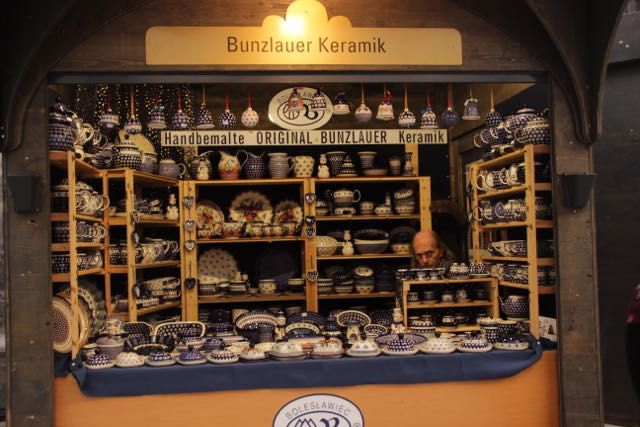

I sent out two emails shortly after arriving in Europe. We're here for 6 weeks. Feel free to skip over them if you've seen them. They catalogue the journey thus far.
- 24th November 2018.
"Currently using the free wifi available on this Swiss train to let you know we flew in to Zurich yesterday after 4 legs of plane flights from Coffs Harbour. We walked the old part of town yesterday afternoon and visited the Christkindl markets. Quite bracing outside but we rugged up and drank hot glühwein. Asleep by 7.00 last night as the jet lag and glühwein took its toll. Currently sitting up at a panoramic window seat, revelling in the luxury of European train travel. Left Zurich this morning and skirted around the shoreline of the Obersee. I told the conductor I want to move here. Stunning Swiss farms and mountain chalets. Everything so green. We’ve just crossed the border into Austria at Feldkirch and are now climbing slowly into the Austrian Alps. Pockets of mist cling protectively to the steep mountainsides and there’s snow on some of them. Heading to Salzburg (a 5 hour trip). The views from the train are worth ten times more than the train fare. This is the only way to travel in Switzerland and Austria. Just passed through the very long Arlberg tunnel and emerged at St Anton am Arlberg. Snow blankets the tracks and the platform. I’m drunk on the scenery of chalets, red painted church steeples, gurgling mountain streams and mountain villages."


2. 26th November 2018.
"This morning it’s snowing in Salzburg. It’s their first snow of the season, which I’m told is 6 weeks later than in previous years. A coating of icing sugar overlays the ancient fortress that sits above the city, and the cobbles of the streets that sit below are slowly morphing from dark, brooding and wet, to white. Yesterday we wandered the christmas markets in the heart of the old part of town. We drank glühwein and nibbled on freshly baked soft pretzel, while watching a large choral group sing on the steps of the Salzburg Cathedral. Taking the funicular railway up to the the fortress, we wandered and lapped up its history, as well as the history of the marionette theatre that Salzburg is famous for. The views down into the Salzach River and the old part of the city (which is UNESCO heritage listed) are amazing. But the main drawcard to this small city is Mozart. This was Mozart’s town and Mozart is everywhere. Concerts, museums, his birthplace and his later home, in shop windows, on chocolate wrappers… Salzburg’s economy loves Wolfgang Amadeus Mozart!


But we’re en route to Vienna at present. These European trains are smooth, sleek, silent. A world of difference to the red rattlers in Australia. The whitened countryside is all pine forests and farms and animals and small towns. And I can’t help entering into the Christmas spirit after overdosing on outdoor Christmas markets yesterday. In the privacy of my head I’m humming, "Dashing through the snow, in an eight car Euro train. And o’er the fields we go, laughing all the way. Ho, ho, ho, ho!” I reiterate, it’s all in the solitude of my head, or the German speaking Austrian passengers would think I’m nuts. But we’re 1 hour into the journey, and the momentum suddenly stops. The train, which earlier was silently snaking towards Linz and Vienna at up to 230 kph, has stopped. We’re sitting unexpectedly in an uninspiring railway station (bahnhof) and the station noticeboard informs us we're in the town of Attnang-Puccheim. We’ve been informed also that there is a 2 hour rail strike right across Austria. All trains, suburban, regional and international, have stopped. It’s snowing consistently, but as a 2 hour prisoner in this carriage I’m not looking at fields and farms anymore. Concrete and steel stanchions are on both sides of the carriage. Bugger. But, as you all read this email, I hear sarcastic muttering, “Awww, poor Doddsy. My heart bleeds for his rotten luck. Bet he wishes he was here at the coalface, working his arse off for the Australian Tax Office like the rest of us.” And they’re right. I snap out of my melancholy thoughts and offer this advice to all - work harder you bastards."
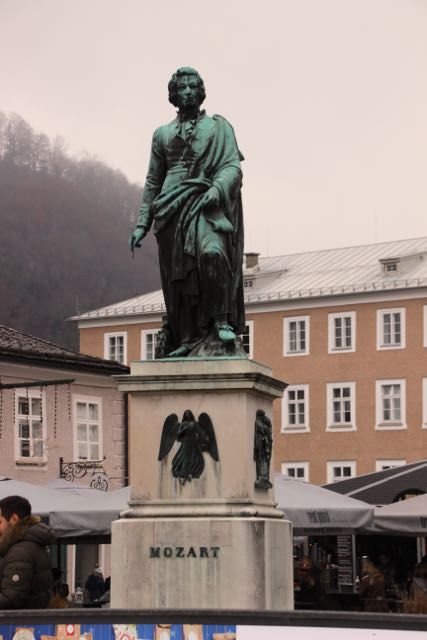
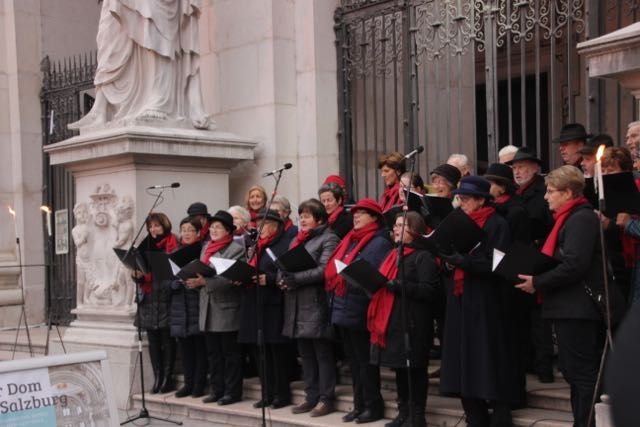
1st December 2018, Leopoldstadt, Vienna, Austria.
Meanwhile, we've been ensconced in our cosy 1 bedroom apartment in Leopoldstadt,Vienna. This area is very conveniently located just across the Danube canal from the historical part of the city. This morning we awoke to a city bathed in 6 to 8 cm of new snow. We rugged up, and walked the Donaukanal (Danube canal) down to the Schwedenbrücke, visited the Karmelitermarkt and lunched nearby, and afterwards wandered home through the popular Augarten park to our home.



Try to visualise this.... the Augarten is a huge, geometrically planted parkland and garden on the edge of the historical part of the city. The trees are skeletal at present due to the ravages of winter, but they are overlayed with new snow. It must be a visual feast in spring and summer. But, juxtaposed to the beauty and serenity of the park, two enormous, grey concrete towers stand within the park. They are the tallest towers in Vienna. The two Flakturm (Flak towers) were built by Hitler during WW2 and used as anti-aircraft defenses against allied aircraft during their bombing raids on Vienna. They are huge, ugly and were impregnable to any allied bombs during the war. They still stand today because, with the thickness of their concrete, the city determined that the amount of explosive needed to demolish them would damage too many homes and buildings nearby, which includes our apartment. They stand today in the midst of a peaceful parkland as a stark reminder of man's historical inhumanity towards each other . It is telling that there is a huge graffiti painted on the side of the largest tower - "NEVER AGAIN."

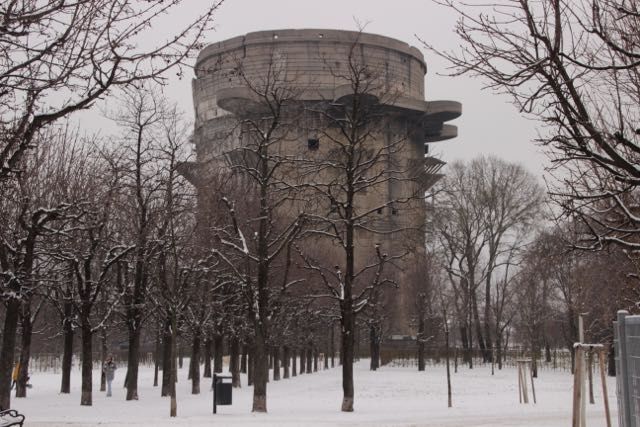
Even more incongruous is the history of events which have been hosted at the huge Hofburg Palace, the home of the Habsburg Emperors including Franz Josef. We visited there and were both awed by the splendour, yet aghast at the in-your-face opulence in which the Austro-Hungarian elite resided. In 1938, Hitler annexed Austria as part of Germany and he addressed hundreds of thousands of Austrians from a balcony at this Palace. In 1938, there were huge parades of troops and machinery of war, and columns draped with swastikas. And 80 years later, we're wandering amongst huge crowds in the same area, which is now adorned with Christmas lights, stalls and Christkindl markets. It's difficult to make a connection between the charm of Vienna last night, with the festivities and colour in front of the Rathaus, and the spectacle of Hitler addressing chanting crowds amidst the frisson and tension of an imminent War.



Our visits to two of the Jewish Museums in Vienna were very humbling and sobering experiences. The Jewish people have had a large presence in Vienna for many hundreds of years. Some of the more wealthy Jews were sometimes used by the Austro-Hungarian elite as the financiers for the excesses, wars, and building programs. Yet Jewish welfare throughout that period has ranged from tolerance (rather than acceptance) to outright hostility. We visited the ruins of the medieval synagogue which was smashed down in the deportation and murder of Jews in the 1400s. Again, in the 1930s and 1940s, all Vienna's synagogues and prayer houses were destroyed and Jewish shops were smashed. Of the 65,000 Viennese Jews who were rounded up and sent to concentration camps, only 2000 survived the war. It's difficult to make a connection with the charm and culture of Vienna today, and this facet of its history.


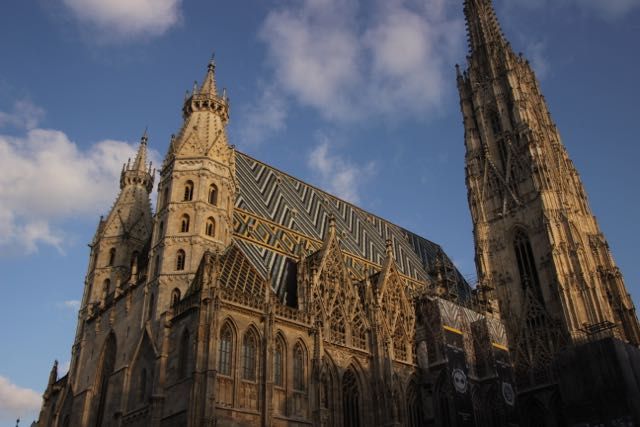
We were invited to a school concert by the lovely Austrian family who own our apartment in Leopoldstadt. They live in another apartment in the same building. This was a school concert with a twist. Their older daughter attends a musical school. She began her school years at the same school as the Vienna Boys choir but, after 4 years together, the boys go off to their own school and Alva went off to another musical school. It is in a stunning old building in the inner city, and the interior looks very Harry Potterish. Alva calls her school Hogwarts. Needless to say, as this was a school for highly musically talented kids and teenagers, the concert was outstanding. Choirs, bands, musical duets, solos. Maybe someday we'll be listening to the recordings of some of these talented musos and not realise that we heard them live in Vienna in 2018!
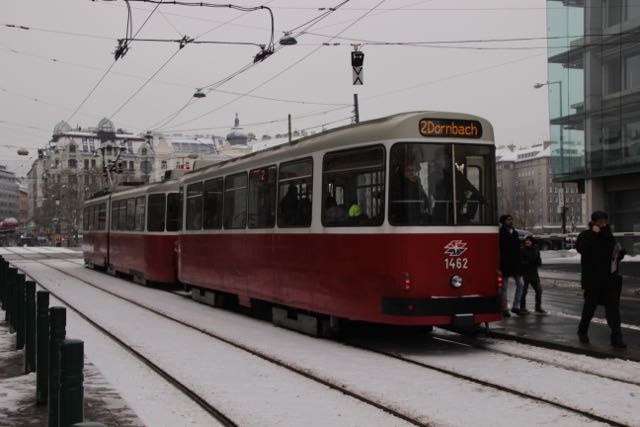
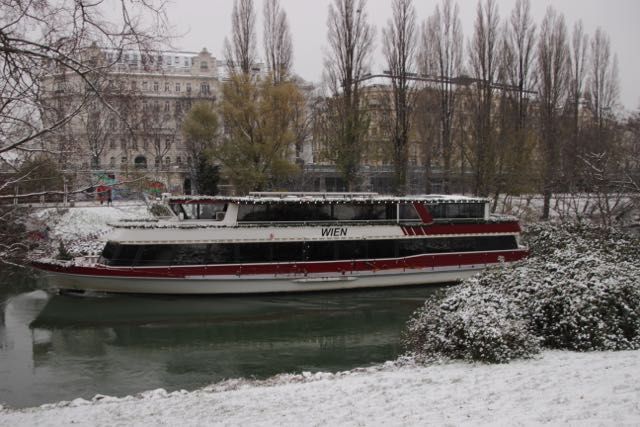
Trams and trains make Vienna easily navigable. There's an extensive system and, armed with our weekly pass, we freely choose to go wherever, although it was a bit daunting to begin with. Vienna is a large city, but we don't seem to wait more than 3-5 minutes for any form of transport. Getting to the city centre and the St Stephansdom (cathedral) is a doddle. And the old city is an architectural feast. Stately, Baroque, Rococo, Medieval. It's difficult to choose which building to explore next. Mind you, across the road from the Vienna Opera House, the concert hall to the gifted and famous, a venue where Mozart conducted, is an Aussie pub! Yechh! It even sells Fosters, which as every Aussie knows, is an exported beer because Aussies generally hate it and reckon it's piped from horse stables. Talk about cultural cringe! They even sell kangaroo and crocodile steaks, and fried grasshoppers. Yeah, that's just standard fare in the average Aussie home! NOT. Makes a mockery of the tacky coffee cups we've seen in souvenir stores - "No kangaroos in Austria!"

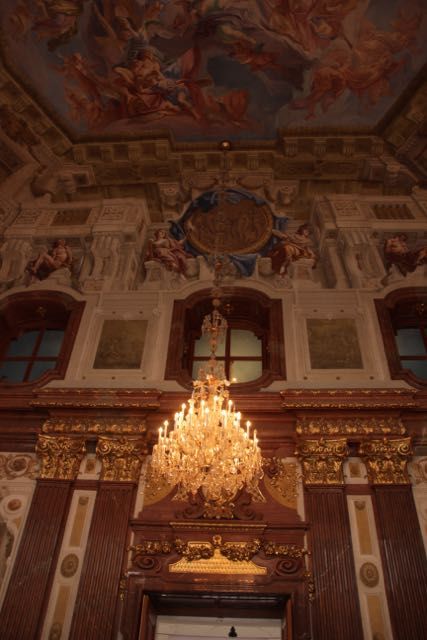
After Van Gogh, Monet is one of our favourite artists. Talk about a lucky streak this week.... not only being in Vienna during the Christkindl market season, but 100 Monet paintings had been assembled at the Albertina gallery as a retrospective of his life. So we've been up close and personal with Monet, and we can authoritatively discuss his use of light under varying atmospheric conditions. Go ahead... just ask me. Yep, I've got culture up to my armpits. Nene Panini almost went into raptures with excitement. Me, I nodded a lot but furtively and unsuccessfully cast my eye around for a glühwein stand. Philistine! But the heady rush from Monet wasn't enough cultural aphrodisiac for Nene. She needed her next hit. Vienna's Belvedere Museum has the largest collection of Gustav Klimt paintings in the world. So guess where we've just come home from tonight? If it wasn't so cold, I'd be perspiring beads of culture.



Yep, we're loving Europe.
David Dodd 3rd December 2018.





